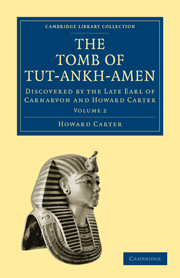Book contents
- Frontmatter
- PREFACE
- Contents
- LIST OF PLATES
- INTRODUCTION. REMARKS UPON EGYPTIAN ART
- CHAPTER 1 TUT-ANKH-AMEN
- CHAPTER 2 THE TOMB AND BURIAL CHAMBER
- CHAPTER 3 CLEARING THE BURIAL CHAMBER AND OPENING THE SARCOPHAGUS
- CHAPTER 4 THE STATE CHARIOTS
- CHAPTER 5 THE OPENING OF THE THREE COFFINS (SEASON 1925–26)
- CHAPTER 6 POINTS OF INTEREST IN EGYPTIAN BURIAL CUSTOMS
- CHAPTER 7 THE EXAMINATION OF THE ROYAL MUMMY
- APPENDICES
- INDEX
- Plate section
- Plate section
CHAPTER 7 - THE EXAMINATION OF THE ROYAL MUMMY
Published online by Cambridge University Press: 05 March 2012
- Frontmatter
- PREFACE
- Contents
- LIST OF PLATES
- INTRODUCTION. REMARKS UPON EGYPTIAN ART
- CHAPTER 1 TUT-ANKH-AMEN
- CHAPTER 2 THE TOMB AND BURIAL CHAMBER
- CHAPTER 3 CLEARING THE BURIAL CHAMBER AND OPENING THE SARCOPHAGUS
- CHAPTER 4 THE STATE CHARIOTS
- CHAPTER 5 THE OPENING OF THE THREE COFFINS (SEASON 1925–26)
- CHAPTER 6 POINTS OF INTEREST IN EGYPTIAN BURIAL CUSTOMS
- CHAPTER 7 THE EXAMINATION OF THE ROYAL MUMMY
- APPENDICES
- INDEX
- Plate section
- Plate section
Summary
To most investigators, and especially to those absorbed in archæological research, there are moments when their work becomes of transcending interest, and it was now our good fortune to pass through one of these rare and wonderful periods. The time that immediately followed we shall ever recall with the profoundest satisfaction. After years of toil—of excavating, conserving and recording—we were to see, with the eye of reality, that which we had hitherto beheld only in imagination. The investigation for us had been one of the greatest interest, nor will it, I venture to hope, be entirely without importance to archaeology. Something at least has been added to confirm or extend our knowledge of the funeral rituals of the Pharaohs in relation to their ancient myths and traditions.
On November 11, at 9.45 a.m., the examination of the royal mummy was commenced. There were present H.E. Saleh Enan Pasha, Under-Secretary of State to the Ministry of Public Works; H.E. Sayed Fuad Bey el Khôli, Governor of the Province of Keneh; Monsieur Pierre Lacau, the Director-General of the Department of Antiquities; Dr. Douglas Derry, Professor of Anatomy in the Faculty of Medicine, Egyptian University; Dr. Saleh Bey Hamdi, Director of the Sanitary Services, Alexandria; Mr. A. Lucas, Government chemist, Department of Antiquities; Mr. Harry Burton of the Metropolitan Museum of Art, New York; Tewfik Effendi Boulos, Chief Inspector of the Department of Antiquities, Upper Egypt; and Mohamed Shaaban Effendi, Assistant Curator, Cairo Museum (Plate XXVIII).
- Type
- Chapter
- Information
- The Tomb of Tut-Ankh-AmenDiscovered by the Late Earl of Carnarvon and Howard Carter, pp. 106 - 140Publisher: Cambridge University PressPrint publication year: 2010First published in: 1927



